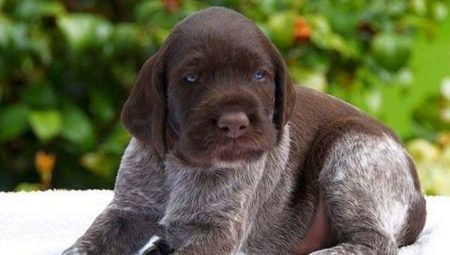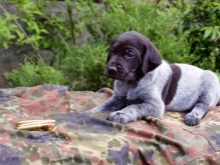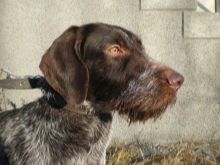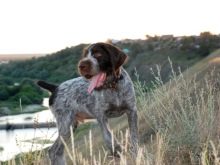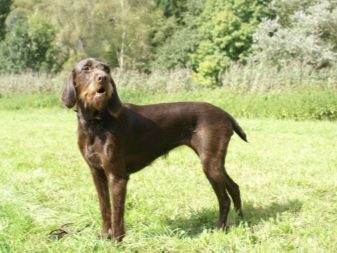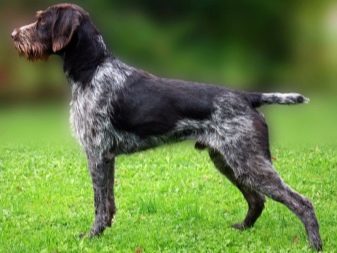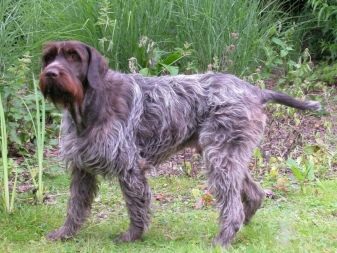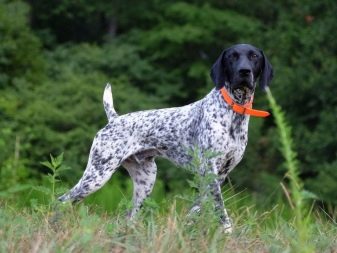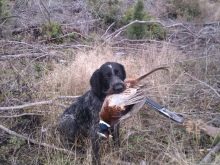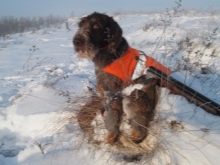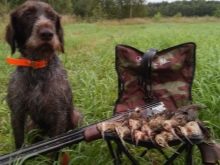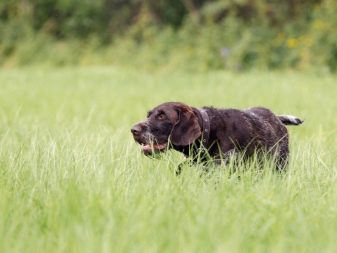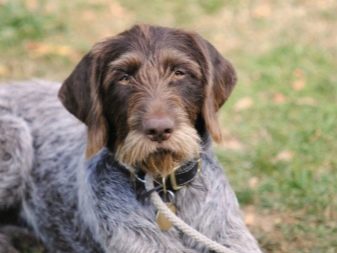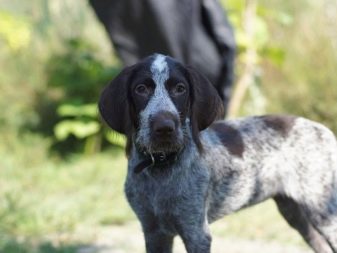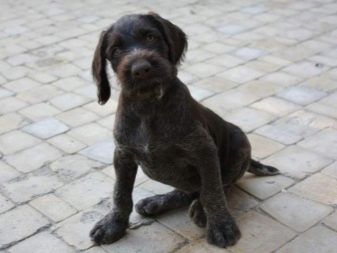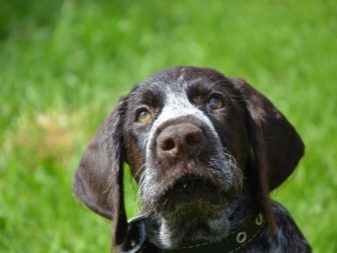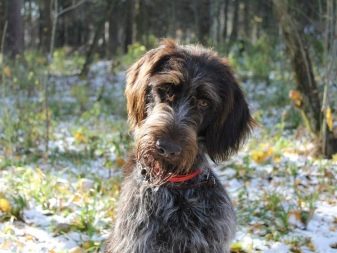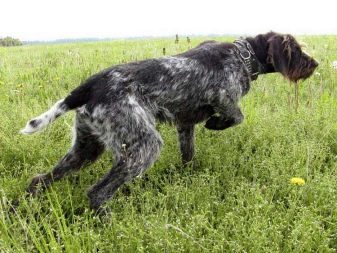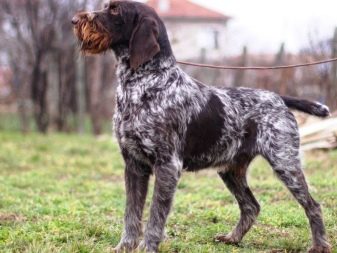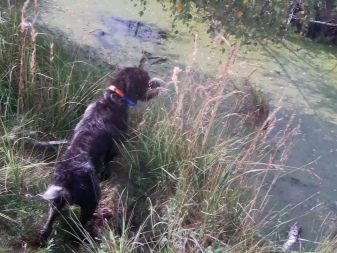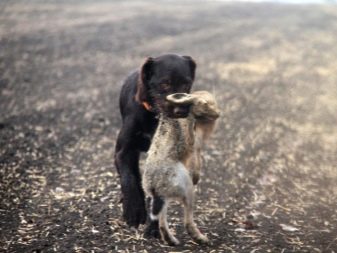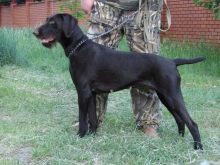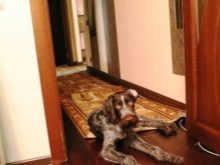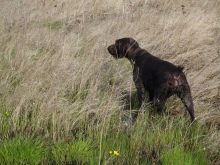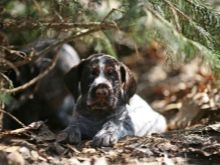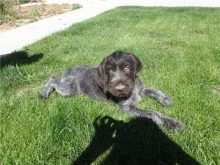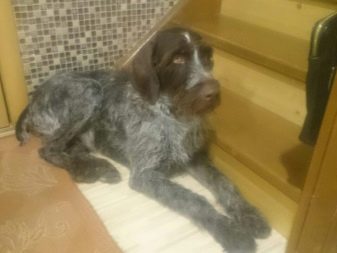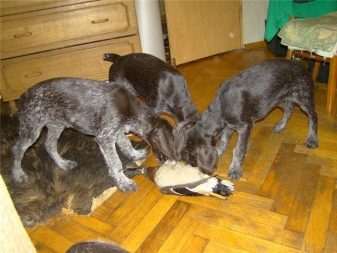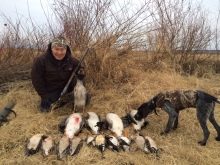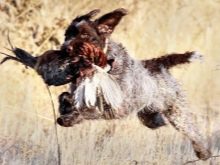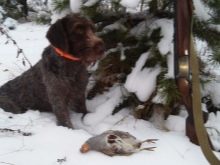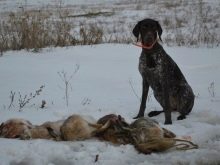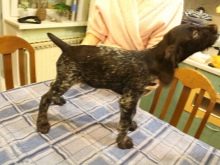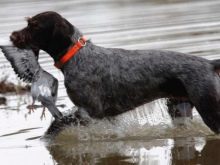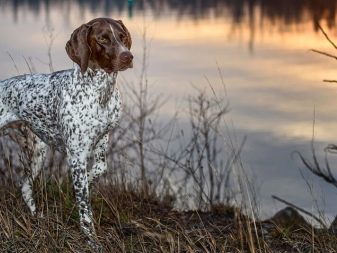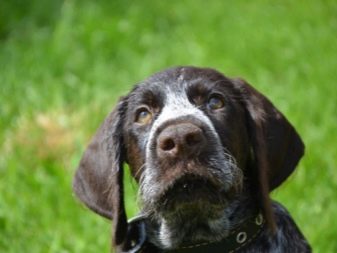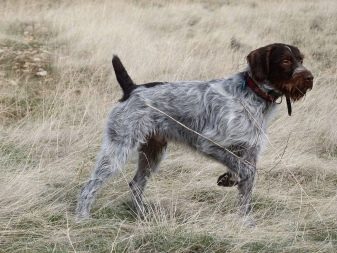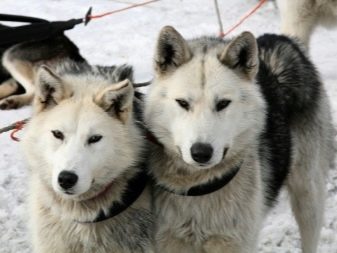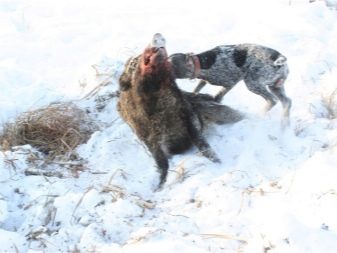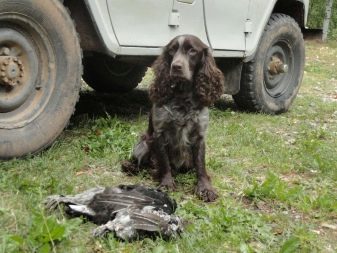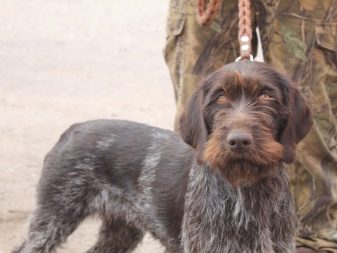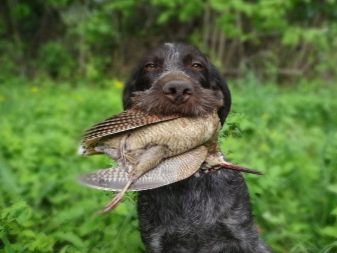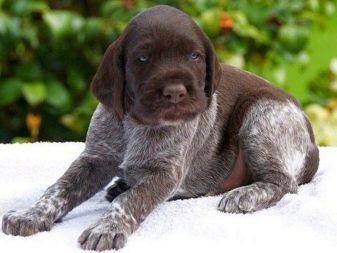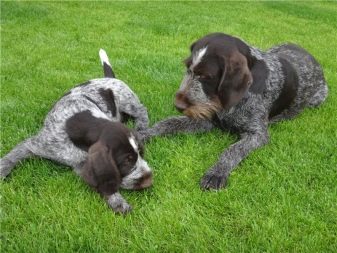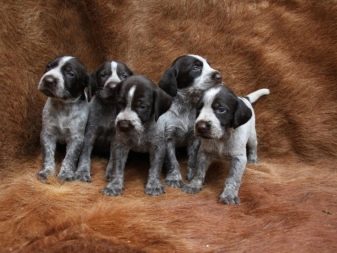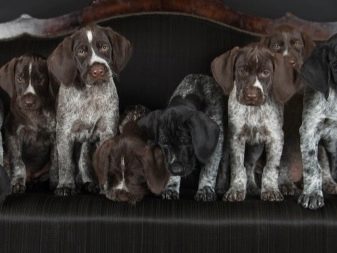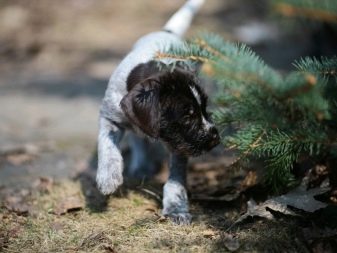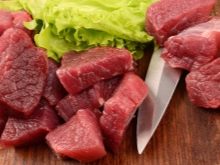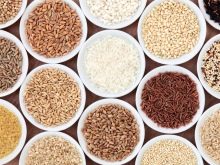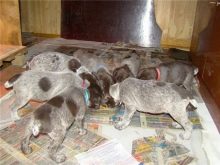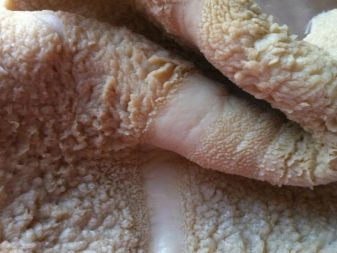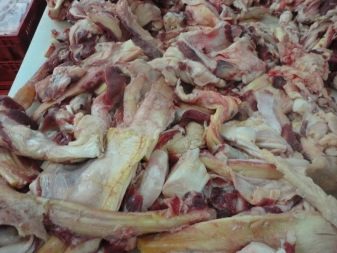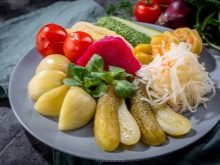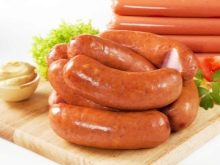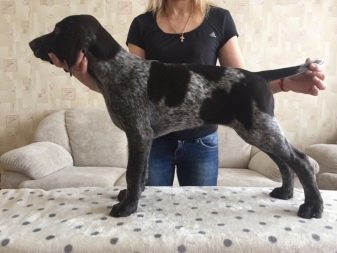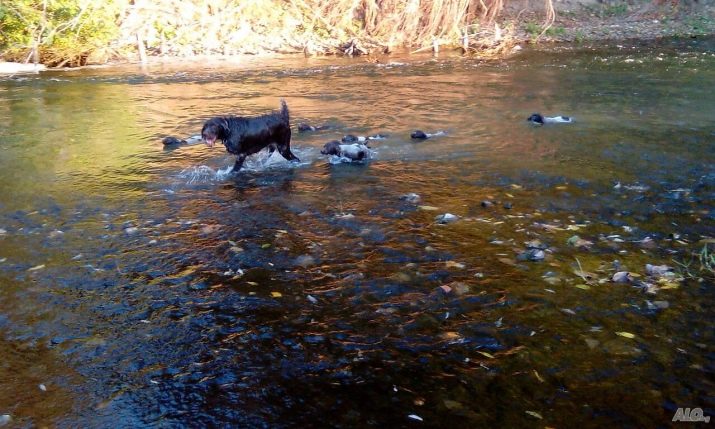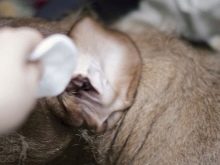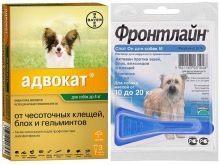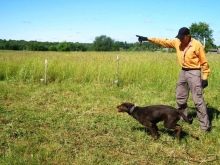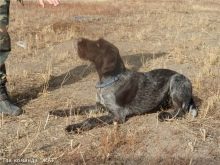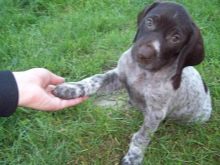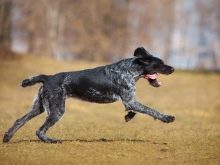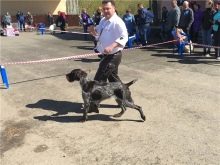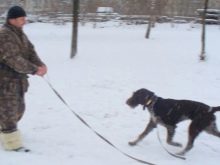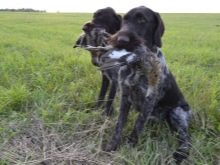German drathaar valued dog breeders around the world. The dog belongs to the class of hunters, it has a lot of advantages and a very original appearance. The material of this article will be interesting to those who want to get acquainted with this animal.
Perhaps this will help the reader to assess his chances as an owner and think about whether a person can give this animal all the necessary things that he needs due to natural features.
Story
The history of the origin of dogs is controversial and intensely debated to this day. However, regardless of the opinions, Germany is considered the birthplace of hunting drathaars. It has long been in this country bred hunting dogs, the quality characteristics of which were famous throughout the world. However, due to the narrow specialization, German breeders had to think about breeding dogs of a universal type. The breeders' task was to bring animals for hunting, which at the same time had all the best characteristics of other known breed dogs at that time.
At the turn of the XIX-XX centuries, work with gene material was particularly active. For crossbreeding, the Poodle-Pointer, Stichelhaar, and Griffon were used. It was from these dogs that the first Dratharas appeared. Breeders tried to bring such dogs that would be able to cope with different tasks, in addition to hunting. And because in the selection of used gene material and local dogs.
Gradually, the appearance of hunting dogs began to change. Its aesthetic indicators improved, animals gained some elegance. Along with this, their hunting and sense of smell have increased. And yet, the breeders did not stop at this, because at that time the dogs could not work for a long time in the water, the reason for which was a short coat of wool. The hunters wanted their pets to be better protected not only from water, but also from difficult terrain.
Thus began the crossing of the Kurzhaars with the wire-haired dogs. There was an improvement in breeding approximately in the interval between 1850-1860. As for the griffons, it is not known for certain exactly what kind of these animals were used to improve the merits of animals. According to one opinion, these were the griffons of Cortals.
The formation of signs of the breed was completed in 1870. At this time, the Drathkaras were already distinguished by their characteristic hard coat. This wool cover perfectly protected animals not only from bad weather and insects, but also saved from thorny branches and helped to work in water. Each puppy passed a strict selection of working abilities and character.
Drathaar perfectly manifested itself in the hunt for wild boars and hares. They were famous as shepherd dogs, because they were coping with livestock grazing. In addition, they could be guards and search engines. And yet, despite the universality, their path to universal recognition was not swift.
At the end of the XIX century, the fashion for exhibitions for dogs reached Germany. At this time, the country was under the rise of nationalism and was united, and therefore, animal standardization began to attach particular importance. Each breeder tried to breed the best dogs, people began to keep breeding books, which led to the formal recognition of the Drathaars.
Very quickly, German hunting dogs became popular in Europe and already in 1920 they came to the USA. However, at first, the Americans did not take the drakhaars in dignity, because they did not believe that the dog could be universal.
Over time, their erroneous opinion dissipated, and therefore the popularity of animals began to increase. Today, these pets are bought not only for hunting: modern breeders like them for their sociable qualities.
Description
Drathaar refers to hardy and strong animals, as evidenced by his developed and toned physique. The versatile dog has a rather attractive appearance. The weight of an individual representative of the breed in the average ranges from 23 to 32 kg, and the female weighs less. Males are larger, their height at the withers varies from 61 to 68 cm, while the size of the bitches is smaller, their height at the withers is from 57 to 64 cm.
These dogs usually live 12-14 years, but under certain conditions this period may increase slightly. If the dog is not provided with proper care, its life expectancy may be reduced. It may depend on various factors, including proper nutrition, regularity of walking, systematics of preventive examinations, as well as hygiene and detection of diseases at an early stage.
The appearance of a Drathaar is memorable: a representative of this breed has a so-called beard, which gives it a certain bit of brutality. Such dogs have a strict, almost military bearing, the original face, due to which the dog seems too serious. In addition to the rare beard, the dog may have a mustache, which is not the case with many of his fellows of other breeds.
The composition of the cops in Germany is average, the constitution is slightly dried, and these dogs are not prone to obesity. The maximum that they can afford is to gain a few extra pounds. Their movements are powerful, sweeping, but at the same time not deprived of smoothness and harmony. The key point of the standard is the fact that the slanting length of the body is almost comparable to the height at the withers. At the same time it is allowed that the length was 3 cm higher than the height.
The shape of the head of the Drathkhaar is wedge-shaped and proportional to both the sex and the growth of the individual animal. The muzzle is somewhat omitted, the cranium is flattened, moderately wide, rounded on the sides.
The cheekbones are pronounced, as is the transition from the forehead to the muzzle. The muzzle itself at first glance seems elongated, not devoid of massiveness.
The lips of the Drathaar are thick with a snug fit, they have sufficient pigmentation, taking into account the coloration of the shirt. The bite of these animals is scissors, the dentition is complete and consists of 42 teeth. Coupling vertical without gaps. Ears are proportional to the body, broad, but not twisted.
The neck is long and dryish, but at the same time muscular, has a small arch. Purebred Germans' eyes have a not too deep landing, they are devoid of bulge, they are characterized by a tight fit and pigmentation of the eyelids. The darker the better. Nose with broad nostrils, as a rule, is colored in any of the colors characteristic of dogs of a given breed.
The body of the Drathaar is barely stretched, may have a sloping back. In this case, the loin of a purebred dog is strong and muscular. The croup is wide, has a slight slope.
The sternum is wide, broad, wide, and prominent, well-distinguished. From the bottom of the body there is a noticeable curved line, which is explained by the fit stomach and the tightness of the groin area.
Drathaaram is characterized by a sufficient reach of the front and a powerful push of the hind legs. Setting the front and hind legs parallel, posture haughty. The skin of these dogs is tight, has no folds. As for the coat, its structure is wire-like. Moreover, this breed is not only a hard-haired: the cops of this species do not suffer from water at all, as they have a waterproof undercoat.
The length of the covering hair in different dogs can vary from 2 to 4 cm. The fur coat does not hide the muscularity of the body, and due to its rigidity and density the animal is not afraid of bad weather or possible mechanical damage. Down on the dog's paws, the dog is shorter and thicker, but not softer. As for the characteristic beard, then this hair is not long, but the toughest.
The color of the animal may be different. For example, in addition to brown-speckled with and without points, it can be black with specks. And in this case, the color may or may not have characteristic spots. In addition to these colors, nature can give a brownish color to the German cop dogs, which can be not only monophonic, but also with a marking on the sternum.
Some representatives of the breed can be painted in rare specks, in which the main background is white, and the markings themselves can be black or brown. Other colors are not included in the standard and are subject to disqualification.
Also disadvantages, among other vicious characteristics of Drathaars, are considered such defects as a weak bite, sparse hair, high-rise, rare undercoat.
Character
Despite the fact that dogs are considered hunting and hounds, they are distinguished by a balanced character. They are extremely intelligent and devoted to their owners. That is why they can become good friends or even companions, which significantly expands the circle of their breeders. Dogs can implicitly obey not only one owner: individual members of the breed obey all households.
However, to call these dogs universal today would be wrong, because their hunting qualities often beat over the edge. Due to the excellent instinct and other characteristics of these dogs are used to work in the Ministry of Emergency Situations. In addition, they can be called assistants for drug control, artists in the circus. Even from these dogs are obtained excellent watchmen.
Since childhood, dogs are characterized by activity and a positive attitude. Movement is their life credo, as is the need for work. Besides the fact that these animals are not afraid of water, they do not get wet and are not afraid of cold temperatures.
Breeders managed to breed a dog breed that can hunt for waterfowl, which is important for hunting owners. Pets do not lose the excitement from childhood, but because their enthusiasm is quickly transmitted to all family members.
It is very difficult to remain indifferent to these funny bearded men. In a difficult moment, they are able to support, and on occasion they will try to pull the master to the game, moreover, they are happy to demonstrate to the owners their tenderness and affection. However, at the right moment, the dogs quickly navigate the situation and move on to protection, displaying the best protective qualities and courage.
In the same time these dogs were not initially aggressive towards strangers. They behave with strangers cautiously, but this can not be said when the dog sees its relatives. Here he is able to manifest a lot of his emotions and feelings. At the same time, communicating a Drathaar with other pets can be very friendly.
A pure-blooded German can live both in an apartment and in a private house.
However, practice shows that the dog that constantly walks in the fresh air, combining walks with adequate physical exertion, will be stronger. Without them, the animal weakens and is forced to seek the output of its energy in other ways.
In no case can a drakhaar be restricted in movement. Even walking with a German dog dog should be special. For example, a dog with pleasure can accompany the owner on a bike ride or a regular sports run. Based on this, it becomes clear that a brat of a drakhaar should also be active and sporty.
Besides, his best qualities for the dog will be organization, responsibility and will. With such an owner, the dog is always ready to run and even swim in a race.Moreover, the animal perceives such walks with special excitement, since the pet adores competitions. And because the activity and responsiveness to any work must be used when training and training.
Unlike many fellows of the canine family, a drakhaar is distinguished not only by intelligence and ingenuity, but also by endurance and patience.
He will not spin under his feet, asking for something from the owners or hurrying the owner for a walk. The dog knows his own worth, but he also agrees with the person quickly enough. He has an excellent memory that can be used during training.
The animal’s hearing and sense of smell are so polished that while hunting this dog is able to find wounded prey hiding in an inaccessible place without much difficulty. After finding it, the dog always informs the owner about his find. With regard to the relationship with the host children, in most cases, the Drathkaras show the qualities of experienced nannies. However, animals rarely give children to sit, because they literally crave outdoor games. In winter, dogs can ride sleds.
As for the individual pets living with the Dratkhaars, in small rodents and birds, the cops see potential prey. Regardless of the education, sooner or later, the dog will hunt for them. If he lives in a private house, he will very quickly destroy not only rats, but also mice (if there are any). This neighborhood is unacceptable for these dogs.
Among the other qualities of the dog is worth noting intolerance loneliness.
In addition to the fact that the animal may miss their beloved owners, individual members of the breed in the absence of the owners can turn their attention to master furniture or other favorite items. Without constant contact with the owner, the dog cannot imagine its existence. Moreover, she will not survive in the conditions of the aviary, especially if the owner will approach her only occasionally to feed.
Advantages and disadvantages
Like any other animals, Drathaars have their strengths and weaknesses. Among the advantages can be noted their ability to penetrate into various hard-to-reach places, which their relatives of other breeds do not have. In comparison with other dogs, these dogs can hunt in any weather, not hiding from rain or wind. They are silent on the hunt and when training are able to collect game by gesture or whistle of the owner.
Besides, as the reviews of the owners show, drathajars almost always come back from hunting with prey. They actively respond to the call for the game and often allow children to "saddle" themselves. A separate category for these dogs are drunk people: the dog’s reason is enough not to demonstrate aggression to a person. With regard to drunken people, the Drathkaras prefer not to attack, but to push them away with their paws.
The advantages include protective qualities. The foreigners prefer not to let the foreigners into the house, if there is no approval from the owner. The dog will growl at strangers, he will rise to warn them, but his teeth and aggression shows only as a last resort. Another advantage of the dog is its ability to hunt not only in the warm season, but also in winter. Drifts will not interfere with him if the owner is going to hunt.
Their indispensable advantage is the ability to cope not only with small prey. If necessary, these animals can hunt together with the owner not only for the bird, but also for the large animal. However, if the breeder does not have a special attachment to the pet and shifts his training from day to day, the dog has every chance to grow stupid, prone to lewdness.
As for the ability of the dog to make independent decisions, this quality can be attributed to both pluses and minuses.
For example, it is very good during a hunt, but when training an individual stubborn person can give the owner a lot of trouble and trouble.Sometimes in communicating with children, the dog actively supports their proposal to fool around, which can lead to pogrom or confusion.
In the absence of training, the animal can behave indifferently to the cats. In some cases, in the absence of other prey, he can drive a cat. If the puppy is early socialized, this problem usually does not arise. The negative point is the jealousy that the animal can show towards the owner. If there are other dogs or cats living in the house, it may seem to the individual Druthaars that those pets get more attention.
Among other shortcomings can be identified and the tendency to escape from rare representatives of this breed. This is explained not so much by a bad attitude on the part of the owner, as by his inattention to the needs of the pet. Fresh vital emotions and sensations are vital for a dog, without incident it suffers. A dog who feels lonely can bite his shoes and spoil everyday objects.
However, the formation of his character occurs during training and education, and therefore grow from a pet a true friend by virtue of any healthy and strong-willed person. As for health, these dogs have a predisposition to certain hereditary diseases.
For example, they often have dysplasia of the hip joints, diabetes, and hypothyroidism. Among other common ailments characteristic of dogs of this breed, such problems as aortic stenosis, melanoma and cataract can be noted.
The main differences from other dogs
Drathaar has its differences from other fellow dog family. For example, if you make a comparison with the Kurzhaar, then these dogs are both cops. However, the Drathaar’s coat is longer, and, in addition, the Kurzhaar is freezing in winter, despite the density of its fur coat. The differences between these dogs lie in their behavior: the kurtshaar is more frivolous and not so aggressive towards the beast. In some ways, he is even friendlier.
The muzzle of the Dratskhaars has a beard, while at their fellows it is covered with fine wool. If we compare the sizes of dogs of two breeds, then they are almost the same, but outwardly, the Drathkaras seem to be larger. Another difference is the degree of simplicity of learning: it is easier to learn and raise a kurtshaar, since representatives of this breed do not question the relevance of any command spoken by the host. As for the character of the mestizo, the dogs have the same need for realizing their own energy. They constantly need to move, they are full of excitement and thirst for adventure. However, the Kurzhaars are prone to dismantling.
If you compare a Drakhaar with a husky, then the breeders have different opinions. Both that and other dog is considered universal. However, by virtue of practice, any animal can be trained on a certain type of game. Huskies are good for hunting fur animals, elk, wild boar, bear and game birds. However, they better cope with medium-sized prey.
The owner must choose a dog based on what he is going to hunt. Therefore, it would be wrong to call any animal better or worse. Experienced breeders believe that the flair in both dogs is excellent, but they hunt for different prey, which explains the key selection criteria. Both the husky and the drathaar silently pursue the prey, and when it is found the husky gives a voice, the drathaar takes the stand waiting for the owner's command.
Convinced fans of the Drathaar believe that he is better. If a dog is trained on a large animal, when it is detected, it gives a voice to the owner, attracting his attention. Some types of huskies are used as sled dogs. However, if a daily workout with physical exertion is vital for a Drathaar, a husky doesn’t need daily activities. But living in an apartment is difficult for her, and besides, she does not hunt a badger and a fox.
As for the differences between Drathaar and Spaniel, there are some nuances. As breeders point out, hunting with a spaniel is different from the behavior of a dog. Spaniels do not always work with the counter, but German is more versatile in hunting. He works both in birds and animals, but without direct contact with large dangerous animals.
Some spaniels do not bring game, others find it in the bushes and give it to the owner. Others fix the wounded paws to the ground, but do not finish. As the owners, hunters, spaniels often raise prey in stride, and with barking.
They can also accompany the hunter with barking all the time, while a drathaar does not allow himself to create excessive noise. It moves quietly, without scaring the prey, relating its work with the commands of the owner.
Popular nicknames
By choosing a nickname for a pet must be approached thoroughly. Not every nickname used by dog breeders today will correspond to the character and appearance of this dog. The first thing to consider is the fact that the name should not be long. Animals quickly remember short nicknames, and it is quite enough that the nickname consists of two (maximum three) syllables. At the same time, the nickname should not be soft, cat-like.
On information portals today, breeders are offered a huge number of options for dog nicknames, but unfortunately, not all of them are worthy of choice. For example, from the list of possible options you should immediately remove the offensive nicknames such as Dirty, Devil, Gryazka, Bes, Shaitan, Hmyr, Rakshas (demon among Indians). Coloring should not be perceived as something dirty and inappropriate.
Understand what you can pick the name of the dog, it is easy, looking at him. Variants such as Demon, Rolf, Makr are not his unique, while the nicknames Gray, Earl will be quite appropriate. Excluded options by the names of family members or friends, as well as nicknames by team names. You should not call a purebred animal such nicknames as Ball, Polkan, Chuk, Huck.
Also, do not give them cat names (for example, Fluff, Marsik, Barsik), including those ending in “ks” (Max, Zeus, Marx), because a consonant nickname will serve as a reason for attention of the dog when someone calls the cat. And even more so it is not necessary to call the dog Apollo, Sultan, Chubais, Ermak, Mephistopheles, Obama, Trump or any other political (historical) figure.
Such nicknames like Archie, Spike, Tucker, Toby, Loyd, Chester, Zack, Jack, Fry, Luke will suit the Drathaar boy. The nicknames Ron, Vinc, Georges, Hyke, Cooper, Diego, Raine, Tao are equally relevant.
As for the Drathkara girls, there are also nuances here. For example, it is not worthwhile to present a dog with stupid nicknames such as Gavka, Shavka, Chakka, Pug, Masya, Tosya, Zita, Dusya, Lyusya. Surely the owner would not like it if his parents called him a Crank or Gimbal. Choosing a nickname, you need to consider the status of the dog, and therefore the name should sound beautiful, sonorous.
For example, a girl could be called Jess (Jessie), Zara, Richie, Chase, Roxy, Remy, Rhonda, Sophie, Chloe. In addition, good options are the nicknames Emma, Terra, Trace, Sheila, Gretta. If you want sonority and status, you can pick up the name, abbreviated from the long, specified in the pedigree.
You should not associate nicknames with hunting (for example, such options as Azart and Attack are completely inaudible). Shelley's nicknames, Salma, Caro are quite harmonious.
Conditions for content
To throw out the dog's energy, a pet must be walked at least twice a day on the street. The dog during the walk should have time not only to play, but also to run, and therefore five-minute walks are not suitable for it at all. In addition, the animal must realize the potential of the hunter. And if the owner for any reason cannot take the dog to hunt, it must be replaced by visits to a special club, where the pet will fully show its talents and skills.
On average, the duration of the total walk per day should be not less than two hours. Moreover, the animal does not need walking tours, and therefore the time allotted for a walk must be used rationally. For example, it may be a combination of a game with a dog training. During the day, the animal must run at least 2 km. In addition to physical activity, the pet needs information. In addition, he loves not only to run and work, but also to dig in the ground, as well as to look for something.
By the arrival of the puppy in the house the owner must prepare in advance. For example, an animal needs its own corner, its belongings and dishes. Your own bed is also needed for the animal to understand its place from childhood.
This is a basic rule that a pet learns from its youngest claws. In addition to the litter, the dog must have its own toys. They can be typical, street or completely edible, so that, along with brushing the teeth, the animal has the ability to temper its hunting ardor.
How to choose a puppy?
To choose a purebred puppy of Drathaar, you should go to the breeder with a photograph, a clear understanding of the breed standard. It is even better to invite a specialist for the purchase, who will have only one glance to understand how the puppy was kept, whether it is healthy, how active it is and whether it is suitable for training on a specific type of prey.
The appearance of the puppies of the German Pointing Dog is quite original. Toddlers have a big head, a typical body for babies and a guilty look. Sometimes he seems sad at all, his forehead is slightly elongated, his paws seem to be large, but in general his constitution is proportional. By 1.5 months, puppies quickly gain weight, and in individuals at the time of purchase, it ranges from 6 to 10 kg.
In our country, purebred specimens registered about 800 units, but for the year the livestock is increasing only slightly. When choosing a baby, you need to pay attention to a number of factors, starting with the pedigree of the parents. The documents should be three marks on the passage of tests, scored in points. The more points, the better, show diplomas with excellent marks are also welcome.
Puppies are taken from the kennel usually when they turn 45 days old. At the same time, the child you like should be active, his coat should shine, his eyes be clean, his auricles should be pink. You can not take kids who have discharge under the eyes, swollen belly, found dandruff, lost back. In addition, you should not buy a puppy with stuck wool, which indicates its poor content and questionable quality care.
What to feed?
The power scheme of a Drathaar may be different. For example, it may be natural food, granulated food, or a reasonable combination of them. However, whatever the type of nutritional ration, in the same meal should not be both ready and dry food. As for the "drying", then this feed is more convenient, because it does not need to be prepared. It is enough to choose from a series of holistic or premium class feeds.
It should contain a lot of natural meat, which is usually indicated on the packaging. Cheap feed is made from meat meal, in which at best there is offal or shredded hooves. Given that there is nothing useful in them, it is undesirable to take them for your pet.
As a rule, dogs that eat cheap food for a long time are susceptible to liver diseases and digestive disorders.
It is impossible to buy food by weight for the reason that after opening a large package, it begins to oxidize. The more he will be on the store counter, the worse his quality will become, as well as the freshness. The best solution would be to choose a small package of granulated product for active wire-haired dogs. In this case, taking the same food each time is undesirable, because the animal needs a variety in food.
Besides, as opposed to natural food, less feeding is required per feeding, since this product is concentrated. However, it is balanced, it contains vitamins and nutrients. When buying such a product you need to pay attention to the age category for which it is designed. In addition to it, it is necessary to provide the dog with constant access to fresh water, and therefore a bowl of water should stand in the kitchen constantly.
If you decide to feed the animal with natural food, we must not forget that it should be rich in vitamins and minerals. The menu should contain products such as lean meat, seasonal vegetables, kefir, cottage cheese. In addition, you must regularly feed your pet buckwheat, rice and oatmeal porridge. At least once a week, the dog must be given eggs.
Puppies need to be fed more often than adult dogs. As a rule, after their purchase, babies are fed approximately 4-5 times a day. As they grow older, the animal is fed less frequently, gradually reducing the frequency of meals and increasing the amount of food consumed. It is better to feed the pet at the same hours in the morning and in the evening. If the puppy is fed "drying", at first the granules are soaked so that they do not harm the formation of the teeth and do not cause the puppy pain.
The daily feed rate is calculated based on the weight and age of the pet. It is divided by the number of feedings.
With ready-made feeds, this is easy, as manufacturers indicate the recommended dosage on the product packaging. Natural food is selected so that, along with cereals and vegetables, the dog eats meat every day.
In the nutritious diet of young individuals should be sinew, cartilage, as well as the scar, necessary for the formation of dog joints. In addition, it will be necessary to provide the pet with vitamin complexes, which are selected not only on the basis of the age of the animal, but also taking into account its state of health. It is impossible to overfeed a hunting dog, because in some cases excess weight may cause systemic diseases.
The list of prohibited foods that are contraindicated in these dogs include any sweets, spicy and smoked food, fried and raw sausage, sausages, pickles and tubular bones. Dogs can not be fed before training or exercise. You can not treat them with food from your table or put their food in the plates from which family members eat. Crockery for animals should be their own, and the bowls should be three: for liquid, food and "sour milk".
How to care?
Caring for your pet will be based on basic hygiene and general rules that are followed for all types of dogs. For example, this is a regular care for wool, teeth, claws, ears, and eyes. In addition, it is necessary from early childhood to provide the pet with frequent check-ups with a specialist, timely administration of the vaccine and anti-parasitic treatment. It is important to show the animal to the specialist not only when it is sick, but also for the purposes of prevention.
As for the care of a fur coat, it will not be difficult due to the structure and length of the coat. If other dogs have to comb the dead wool for a normal growth for a long time and also save it from tangles, nothing will be needed here.
Even during a molt, which usually happens twice a year, a drathaar does not drop too much hair. If the dog lives in an apartment with dry and warm air, the molt can last almost constantly.
In order for his wool to be updated in a timely manner, the breeder needs to comb a pet with a special comb no more than once a week. During molting, the multiplicity of procedures should be increased to two times a week. Considering that all combs are not suitable for this dog, it is necessary to buy a version with metal teeth, choosing an accessory for grooming, taking into account the size of the dog, the length of his coat and its thickness. If the comb is chosen in the store incorrectly, it will increase the time of combing dead wool and can make the procedure painful.
Dratkhaars are rarely bathed (mostly once every six months). However, if the dog has returned from hunting or walking too dirty, you can not do without washing. Breeders should take into account such a feature as the loss of hardness of a fur coat and its natural qualities during frequent bathing with a zoo shampoo. If desired, the pet will never refuse to splash in an open pond.
The dog’s ears should be inspected constantly, as it is polluted, the shells are freed from sulfur. If in these zones the owner detects inflammation or an unpleasant odor or liquid, the dog should immediately be taken to the veterinarian for an appointment. It is also necessary to engage in eye hygiene to prevent the likelihood of clogging and inflammation. About once a week they are wiped with a damp cotton pad moistened with a weak solution of tea or chamomile.
After walking it is necessary to wipe and inspect the dog's paws for the presence of wounds, splinters and cracks. If the paw pads are covered with cracks, this indicates a lack of fat, and therefore it is necessary to include vegetable oil in the nutritious diet.
In addition, vegetable oil must be lubricated and cracked pads. Once a month it is necessary to treat the animal with antiparasitic agents against fleas and ticks.
Upbringing and training
As practice shows, the sooner the owner starts training a puppy, the better and faster the pet is trained. To memorize the simplest commands, a puppy needs no more than 2-3 workouts. The commands “sit”, “voice”, “lie down”, “stand” and “cannot” the pet remembers instantly. He doesn’t need to constantly reinforce the acquired skills, as the dog remembers these commands all his life.
Drathaar can please their owners with presents in the form of caught rats or field rodents. Their mentor must be firm and serious in education. However, there is no question of any abuse of the authoritarian style of communication with the dog.
The pet feels very subtly where and when the owner shows weakness, and therefore can quickly seize the initiative in their paws, starting to manipulate its owner.
The courage of the dog is instilled in his childhood, encouraging the puppy's bravery in training, his nephobia of shots and the type of prey, no matter how large its dimensions. Smells of gunpowder and gun salvo, the kid remembers while hunting, far from public places and civilization. At the initial stage of training, the puppy should hear shots at a distance of approximately 200 m from it. If they do not frighten him, the distance between the pet and the shot is gradually reduced.
The first training is best done under the guidance of a dog handler or a huntsman. Often in the course of study include swimming lessons in open water. Since individual puppies are afraid of water since childhood, swimming training should be gradual, beaten up by any game.
Monotony in training is unacceptable, as is rough treatment. In such cases, the pet loses respect for its owner and ceases to see him as his idol.
Lessons should be combined with dashes, games and tasks for ingenuity. You can teach wearing puppy items at 5 months. He is ready for aportirovka when he learns to immediately and correctly respond to the master's commanding voice. In the first lessons of training, a stuffed bird is used, which the dog must learn to bring at the request of the owner.
On average, the pet should bring about four types of prey to the host. In this case, the occupation technique can be represented as an imitation of the hunt. Here the dog learns perseverance, acceptance of the rack, as well as waiting for the team of its owner. It’s good if from childhood a pet is taught to hunt not only a waterfowl, but also a pheasant and a hare.
For the Drathaar breed, see below.
